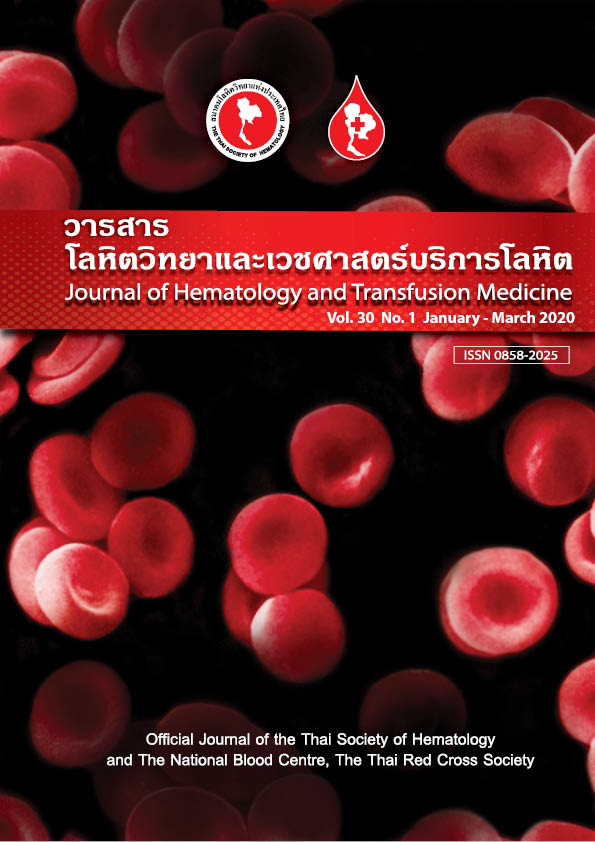Clinical features and outcomes of thrombotic thrombocytopenic purpura with severe ADAMTS13 deficiency at Maharat Nakhon Ratchasima Hospital
Keywords:
Thrombotic thrombocytopenic purpura, Severe ADAMTS13 deficiency, Plasma exchangeAbstract
Abstract
Introduction: Thrombotic thrombocytopenia purpura (TTP) is a rare but serious disease that is characterized by the microangiopathic hemolytic anemia (MAHA), thrombocytopenia, neurological abnormalities, renal impairment and fever, the so-called pentad. However identifying cases who completely fulfill the pentad is unusual and its various clinical presentations cause difficult diagnosis and high mortality rate.
Objective: The study aimed to review clinical data, laboratory data, therapeutic interventions and treatment outcomes of patients with a diagnosis of TTP at Maharat Nakhon Ratchasima Hospital (MNRH) between January 2007 and June 2017.
Result: In all, 22 TTP patients received a definite diagnosis with severe ADAMTS13 deficiency. Their mean age was 59.8 years. Twenty were classified as idiopathic (91.0%) while two were SLE-associated TTP (9.0%). All patients had MAHA and thrombocytopenia, 93% had neurological presentations, and 45.4% had bleeding disorder. Their mean laboratory data included hemoglobin concentration, platelet, and creatinine level of 7.1 g/dL, 11.4 x109 /L and 1.7 mg/dL, respectively. Only 36.3% of patients had the full pentad of TTP. Their treatments at the time of diagnosis consisted of plasma exchange in 11, plasma infusion in 10 and only immunosuppressants in 1 patient. The mean interval between symptom onset and plasma exchange was 6.6 days. The complete remission rate was 50%. Two patients relapsed only within the first year, one could achieve complete remission again by plasma exchange with immunosuppressants but the other patient passed away. The overall mortality rate was 50.0%.
Conclusion: Almost all patients with TTP in our series had neurological symptoms clinically mimicking ischemic stroke, so the diagnosis could be delayed and might be the cause of the high mortality rate.
Downloads
References
1. Kremer Hovinga JA, Vesely SK, Terrell DR, Lammle B, George JN. Survival and relapse in patients with thrombotic thrombocytopenia purpura. Blood 2010; 115: 1500-11.
2. Jang MJ, Chong SY, Kim IH, Kim JH, Jung CW, Kim JY, et al. Clinical features of severe acquired ADAMTS13 deficiency in thrombotic thrombocytopenic purpura: the Korean TTP registry experience. Int J Hematol 2011; 93: 163-9.
3. Aumpan N, Akkawat B, Rojnuckarin P, Sosothikul D, Uaprasert N. Clinical characteristics and outcomes of thrombotic thrombocytopenic purpura with severe ADAMTS13 deficiency at King Chulalongkorn Memorial Hospital. J Hematol Transfus Med 2015; 25: 43-53.
4. Krudpoo P, Rattarittamrong E, Norasetthada L, Tantiworawit A, Chai-adisaksopha C, Nawarawong W. Clinical manifestations of thrombotic thrombocytopenic purpura in Maharaj Nakorn Chiang Mai Hospital. J Hematol Transfus Med 2013; 23: 217-26.
5. Zheng XL, Kaufman RM, Goodnough LT, Sadler JE. Effect of plasma exchange on plasma ADAMTS13 metalloprotease activity, inhibitor level and clinical outcome in patients with idiopathic thrombotic thrombocytopenic purpura. Blood 2004; 103: 4043-9.
6. Scully M, Hunt BJ, Benjamin S, Liesner R, Rose P, Peyvandi F, et al. Guidelines on the diagnosis and management of thrombotic thrombocytopenic purpura and other thrombotic microangiopathies. Br J Haematol 2012; 158: 323-35.
7. George JN. Clinical practice. Thrombotic thrombocytopenic purpura. N Engl J Med 2006; 354: 1927-35.
8. Bianchi V, Robles R, Alberio L, Furlan M, Lämmle B. Von Willebrand factor-cleaving protease (ADAMTS13) in thrombo-cytopenic disorders: a severely deficient activity is specific for thrombotic thrombocytopenic purpura. Blood 2002; 100: 710-3.
9. Sathawarawong W. Thrombotic thrombocytopenic purpura (TTP): 4 case reports and review of the literature. J Med Assoc Thai 1995; 78: 322-31.
10. Rock GA, Shumak KH, Buskard NA, Blanchette VS, Kelton JG, Nair RC, et al. Comparison of plasma exchange with plasma infusion in the treatment of thrombotic thrombocytopenic purpura. N Engl J Med 1991; 325: 393-7.
11. Crawley J, Scully M. Thrombotic thrombocytopenic purpura: basic pathophysiology and therapeutic strategies. Hematology Am Soc Hematol Educ Program 2013; 2013: 292-9.
12. Porta C, Caporali R, Montecucco C. Thrombotic thrombocytopenic purpura and autoimmunity: a tale of shadows and suspects. Haematologica 1999; 84: 260-9.
13. Coppo P, Bengoufa D, Veyradier A, Wolf M, Bussel A, Millot GA, et al. Severe ADAMTS13 deficiency in adult idiopathic thrombotic microangiopathies defines a subset of patients characterized by various autoimmune manifestations, lower platelet count, and mild renal involvement. Medicine (Baltimore) 2004; 83: 233-44.
14. Bendapudi PK, Hurwitz S, Fry A, Marques MB, Waldo SW, Li A, et al. Derivation and external validation of the PLASMIC score for rapid assessment of adults with thrombotic microangiopathies: a cohort study. Lancet Haematol 2017; 4: e157-e164. doi: 10.1016/S2352-3026(17)30026-1.



